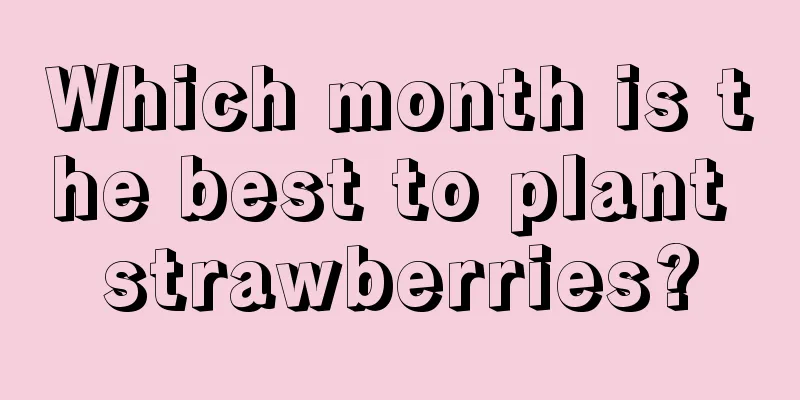Which month is the best to plant strawberries?

|
Strawberry cultivation generally prefers warm and cool climatic conditions. Its roots can grow in the temperature range of 5-30℃, and the most suitable temperature is 15-22℃. The suitable temperature for the growth of stems and leaves is slightly higher, at 20-30℃. Strawberry buds are susceptible to frost damage in extremely low temperatures, i.e., -15 to 10°C. Let’s learn together which month is the best to plant strawberries? Which month is the best to plant strawberries? Usually, greenhouse strawberry cultivation can be achieved all year round as long as the environmental conditions are properly controlled. Strawberries grown outdoors are usually planted from March to April each year, and their fruit ripening period is generally from June to July. After the strawberries are harvested in June and July each year, if you plan to transplant them, you should plant them in late summer or early autumn. To ensure the growth of the plants and the quality of the fruits, the latest sowing time should not be later than mid-August. Key points for strawberry cultivation 1. Site selection The land for planting strawberries should be slightly higher, flat, easy to irrigate and drain, with sufficient sunlight, rich in organic matter, good water retention and air permeability, and slightly acidic or neutral fertile soil. The previous crops should be vegetables, beans, melons, wheat, etc. Before planting strawberries, weeds should be removed thoroughly and fully decomposed farmyard manure should be applied. Generally, 5,000 kg of organic fertilizer , 50 kg of superphosphate and 50 kg of potassium chloride are applied per mu as base fertilizer. After spreading the fertilizer evenly, till the soil 30-40 cm deep to promote soil maturation. After the land is leveled, make ridges with a width of 100 cm, a ridge surface width of 80 cm, a ridge ditch width of 20 cm, a ridge height of 15 cm, and a ridge length of 20 meters. 2. Planting The quality of planting directly affects the growth and subsequent management of strawberries, so careful operation is required. When planting, care should be taken to point the arch of the strawberry seedlings toward one side of the ditch so that the inflorescences grow in the same direction. Plant one plant in each hole, and the planting depth should be such that the heart is not buried and the roots are not exposed. 3. Reasonable density planting The planting density of strawberries is closely related to the planting conditions . Fields with weak seedlings, late planting and lack of fertilizer should be planted densely, about 8,000 plants per mu; fields with strong seedlings, early planting, sufficient fertilizer and those using mulching technology should be planted sparsely, about 6,000 plants per mu, and the row spacing should be maintained at 50 cm × 20 cm. 4. Watering After planting, water thoroughly once, water once in the morning and evening within a week after planting, and then keep the soil moist to facilitate survival. 5. Fertilization Strawberries require more fertilizer from planting to flowering and fruiting. In addition to applying sufficient base fertilizer, it is also necessary to add fertilizer in time. During the fruit expansion period and the beginning of harvest, 10 kg of strawberry-specific fertilizer or diammonium phosphate can be applied per mu. Combined with watering, it is better to apply 200 times liquid fertilizer in the ditch. For fields with good growth, spraying 0.1-0.2% potassium dihydrogen phosphate 2-3 times can also have a certain yield-increasing effect, but in principle, spraying is not done during the flowering period. The principle of fertilizing fruit fields is to use appropriate amounts of nitrogen fertilizers and heavy phosphorus and potassium fertilizers, maintaining a reasonable ratio to obtain higher yields and maximum benefits. 6. Coverage Mulching can significantly promote early maturity, increase yield, improve fruit quality and increase the commercial fruit rate. Generally, film covering begins in mid-to-late March. Be sure to remove dead and old leaves on the plants before covering them with film. 7. Harvest The harvest period is the busiest season for strawberry farmers. In addition to harvesting and marketing, other field management tasks are also required: Diseased leaves, yellowed leaves and diseased fruits should be picked off frequently, taken out of the strawberry field and buried deep to reduce diseases and pests. Remove new stems frequently. During harvesting, if you find that the fruit is half red and half green, you can turn it over to promote even coloring. To sum up, this is an introduction to the planting time and methods of strawberries. If you are cultivating them in the open field, you must pay attention to the planting time. During the planting process, you must also control the strawberry's requirements for planting conditions.
|
<<: Which month is best for transplanting onions?
>>: What is the reason why beans do not grow vines?
Recommend
When should sweet potatoes be planted?
Sweet potato tubers are rich in protein, starch, ...
Can Lover's Tears be hydroponically cultivated? How to root them hydroponically?
Can Lover's Tears be hydroponically cultivate...
Is garlic a shade or sun-loving plant?
Does garlic prefer shade or sun? Garlic is a sun-...
What kind of flowerpot is suitable for gardenia?
What kind of flowerpot is suitable for gardenia W...
Cultivation methods and precautions of star wood
How to grow star wood temperature Starwood likes ...
When is the best time to sow green vegetables?
Suitable time for sowing green vegetables Pakchoy...
The efficacy and function of desert rose
Medicinal effects: 1. Desert rose can be applied ...
How to save seeds of gladiolus
Where do gladiolus seeds come from? Gladiolus is ...
How to prune roses
Rose pruning The best time to prune roses is in a...
Milan flower varieties
Mizilan Milan is a native variety of Milan, with ...
Does Allium orchid prefer shade or sun?
Does Allium orchid prefer shade or sun? Allium or...
What do yam leaves look like? Pictures of yam leaves
1. Leaf shape The leaves of yam generally vary gr...
Cultivation and precautions of zapota
1. Lighting The lily of the valley is a plant tha...
Plants are afraid of the cold, so is it enough to just bring them indoors?
Do your plants hate the cold? Common home-grown f...
The cultivation methods and precautions of Tangyin
Family farming methods temperature The Tangyin, w...









